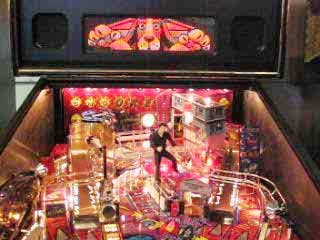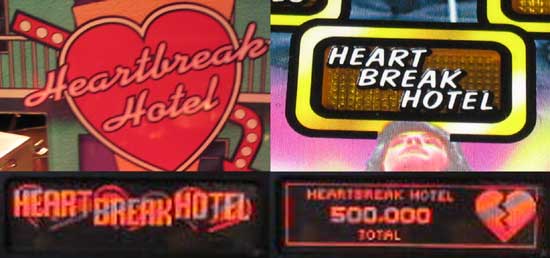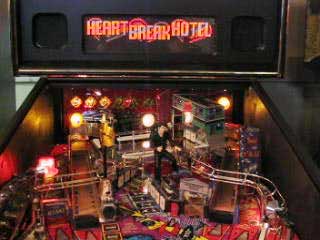|
|
|
ELVIS
|
|
In part one of this review we toured the playfield and saw the game's features and toys. Now we'll look at the rules of the game, see how the scoring works and reach some conclusions about the whole package. Nothing much is hidden about the objectives in Elvis. It's all there on the playfield in big, brash lettering.
Taking them in order, first is "Featured Hits". They are the five modes shown just above the flippers, each one taking its name from a famous Elvis hit which is played - complete with animated Elvis - when the mode starts.
Hound Dog is started by repeatedly hitting the Hound Dog target - that's the one with the dog.
The exception to this is the spinner on the left loop which is treated as a special case. Not only does the sound of the woofs generated by the spinner override all others, it is unique in that the pitch of the woofs changes according to the speed of the spinner. It's a nice and strangely humorous effect. The initial duration of Hound Dog mode is 30 seconds but it can be extended by an award from the Scarf target and it continues through other modes and multiballs. As with all the modes it will also award double points if TCB double scoring is running. When the timer runs out you are shown your total for Hound Dog mode on the display. There is a brief grace period to grab a few more woofs before this happens though and this grace period is common across all the modes too. Although the Scarf award can give you more time, on this version it appeared to make little or no difference to the clock as you can see in the video clip above. Blue Suede Shoes is probably the most confusing and the most difficult mode to start. It is all based around the inner loop shot and you need to make that a number of times sequentially to kick it off.
The first time round the loop lights it briefly it for qualifying loop shots. You have a few seconds to make one of these before the time runs out and you need to qualify it again. There is a helper in the shape of the right inlane. If you make that and then shoot the ball up the left loop, the inner loop is immediately qualified so all loop shots count. Between qualifying loops, the ball is held by the magnet above the upper right flipper giving you time to line up the shot. But with this version of the software, the ball frequently sailed right past it when it surely should have been stopped. It may have been due to a flaky switch in the right loop or perhaps it is supposed to work this way but either way it seemed very inconsistent. The first time you need to score two qualifying loops to start the mode and they can be scored either individually or together with sequential loops. The second time around you need three qualifying loops and so on. Once you've collected the requisite number of qualifying loops the mode starts. A 30 second timer begins and you need to shoot the inner loop to collect Blue Suede Shoes awards. They're not called jackpots and are worth 400K, increasing 50K each time they are collected.
Regardless of the spelling, balls are locked on the upper playfield (reached from the left ramp) by shooting at the hotel until the door opens and then putting the ball through the doorway into the lock area located beneath.
The first time, you only have to lock one ball but after that, three balls need to be locked to start the multiball. In this case you get a "Shoot the Hotel" dot matrix animation that will look very familiar to owners of many Data East games from Lethal Weapon 3 onwards. All locks are virtual and the ball is quickly returned into the right loop lane each time.
Make the shot successfully and you get the Heartbreak award of 2M points which increases 2M each time. Shooting the Scarf target will often add another ball (up to the maximum of four) to the multiball and TCB double scoring also helps the points rack up.
Shoot the saucer to start the multiball or, later on, shoot it to light lock and then lock balls. Again, all locks are virtual but the saucer is nowhere as easy to shoot as it looks. The gap is only marginally wider than the ball so it's very tight and just as likely to be scored by accident as by intent. Once the multiball starts, the ball is kicked out and two more are autolaunched. The saucer is then lit for Jackpots (and they are actually called Jackpots not awards) starting at 1M and advancing 1M each time. Meanwhile, all the white arrowed shots on the playfield (all loops and ramps) are lit to advance J-A-I-L-B-R-E-A-K. This is shown on the display but not on the playfield, so you have to keep looking up to check on your progress. Once you complete J-A-I-L-B-R-E-A-K the saucer is lit for Super Jackpot which is a nice juicy value around 10M. Collect that and you're back to the start collecting regular jackpots and building towards the next super. All the usual rules about Scarf and TCB apply here so double scoring is essential when going for the Super Jackpot. One of the inherent problems with using the saucer for Jackpots and Super Jackpots during multiball is telling whether the ball was shot into the saucer or whether it rolled in from the pop bumpers. In the case of Elvis, the problem is circumvented by always giving the award, so if you're having trouble shooting the saucer directly, just send the balls into the jets and hope.
The left loop, the left ramp and the right ramp spot "All", "Shook" and "Up" respectively. Collect all three in any order and the 30 second timed mode begins. It's a simple case of shooting any of those three shots again to collect ASU awards starting at 500K points and increasing by 100K each time one is collected. Because of the simplicity of starting it and the relatively low scoring, it's worth holding this mode until you start one of the others such as a multiball and then kicking it off in conjunction with 2x scoring and perhaps a Hound Dog.
So those are the five modes you need to start to light the Featured Hits section on the way to Graceland. There are no requirements to achieve a certain level in each mode, just starting them is enough. Next on the list are the Gifts From E-L-V-I-S. Note the punctuation here as it refers to the E-L-V-I-S drop targets on the left hand side and the awards they enable which are collected by shooting the right loop to the top saucer.
The first award is entitled Flip Flip Dance Dance and is the game's sole video mode. It's loosely based on the dance games you see in arcades and shows the strings of a guitar with two static arrows pointing left and right on the far left of the screen representing the left and right flipper buttons. Other arrows scroll across the the screen towards the static ones and when they hit you have to press the appropriate flipper button at just the right time. The scrolling arrows can be singular or in pairs and you are marked according to whether you press the correct buttons and the timing of your flips. There is a music backing track (an Elvis song, naturally) and the timing is arranged so the arrows hit on the music beats. After so many arrows have passed you are given your score based on the number of hits in the following categories: Miss, Bad, Good, Great, Perfect and Combos. Unusually for a video mode, it's one you can practice and improve as it's based on skill and not luck. Each time you play the mode the speed of the scrolling arrows increases making it harder to get the timing right, but in this version of software the difficulty maxed out at level 3 no matter how many times you played it.
Light Extra Ball is the next award and that is collected at the top saucer. This version had a bug where collecting the extra ball when Flip Flip Dance Dance is also lit could result in an instant 0 points for the completed video mode. Finally, E-N-C-O-R-E letter adds one letter to E-N-C-O-R-E displayed on the back board. When complete you get the extra 30 seconds of 4 ball multiball when the regular game ends as previously described. Once you've received all the gifts (even if you haven't yet collected the extra ball), the middle insert is lit on your path to Graceland. The final piece is Top 10 Countdown and that's the easiest one to describe.
Each of the five major shots has a blue note symbol and at the start of the game a number of them are lit. When you make these shots the notes go out and when you put them all out you move one place up the chart (shown surrounding Elvis in the picture above). The announcer tells you when a hit is collected but the song isn't played. If there's one especially tricky shot you just can't make, you can always shoot the white standup target on the right which spots one of the lit notes for you. Reach number 1 and you've completed the feature which then resets. So, if you've completed the three steps to Graceland you can start the wizard mode, right? Well, not quite yet. If you've got any mode running you have to wait for it to finish before Graceland is lit at the top saucer. When you do start it, you get a brief animation (unless you're also collecting an extra ball in which case you probably won't) and some instructions flash up. These begin "Tour the Mansion" which is good for a chuckle if you're an Addams Family fan. You have to shoot all five major shots to collect jackpots and advance through the rooms of the mansion. While you do this, the jackpot value is shown on the display, not your total so far, so it can appear that you're not achieving much despite all your efforts. I can't tell you any more because that's as far as I got, so you'll have to find out what happens after that for yourself.
This bonus can reach a serious number of points. In one game it exceeded 60M which was almost the replay level so it's important to keep that nudging under control if you're having a good ball. You also get one of a series of Elvis quotes as a comment on your bonus score. The match animation consists of a curtain coming down on the word "Match" and rising to reveal the number. Unexciting but mercifully quick.
First impressions are very favourable. It looks fabulous with the rich purples and reds exuding a class only slightly diminished by the comic-looking typeface used on the playfield. What that font does add is clarity. You're never squinting at the inserts to see what they say because the type is brash, bold and largely avoids trying to cram too many words into a small space. Unfortunately, this is exactly the problem on the Gifts from Elvis board. The writing is tiny, on a curve and at an awkward angle with no means to differentiate between the awards. It's a minor point but one that sticks out because it contrasts with the apparent philosophy of the rest of the game. If the game looks great, how does it play? Unfortunately, the phrase that comes to mind is "a bit clunky". Perhaps it's those metal ramps or because it was a brand new game, but it's got the same tight mechanical feel to it that T3 did. But where that title lends itself to a certain amount of industrial solidity, Elvis should surely feel rather smoother and less snappy? The colour scheme softens it off somewhat but the feel is still robust.
That solid feel is justified because the game is very well put together. Nothing broke or looked in any way fragile on this model and there's not much to go wrong either. The Heartbreak Hotel door is a tried and tested design from The Simpsons Pinball Party and I think we can take it for granted that Stern know all about saucers and drop targets, so the only area left is the dancing Elvis. But even here, the one toy that has any mechanical complexity is irrelevant to gameplay, so this game should keep on earning without the need for constant service calls. Despite the apparently busy playfield, it's actually a very open game. Because all the action is concentrated at the top of the game there are no important sucker shots and even a failed ramp shot has half the playfield to travel before it reaches the flippers giving you plenty of time to do something about it. So with no dangers lower down the game, it seemed quite easy to achieve long ball times and high scores on factory default settings. The rules are quite straightforward and not overly complex with some nice touches for those paying attention and opportunities for some strategic planning to get the most from each mode. The three-pronged route to the Graceland finale forces you to experience all the game's features at least once making the rules broad rather than deep and the wizard mode appears achievable. When reading Stern's press release and seeing "In the ELVIS® pinball machine Elvis sings, 'See See Rider', 'Blue Suede Shoes', 'All Shook Up', 'Hound Dog', 'Jailhouse Rock', 'Heartbreak Hotel' and 'Burning Love.'" you might wonder how on earth they get all those songs into the game and the simple answer is.....by cheating. Yes, Elvis does indeed sing - and dance to - all those songs, but only the first verse or so, with the rest being plain orchestration. Here's the opening track See See Rider as an example. Click here to hear See See Rider, MP3 384K It's all quite reasonable and you may not even realise The King has stopped singing when the music continues, but don't expect to get full versions of all those songs into a pinball game. Not yet, anyway. The other sound effects are well presented although putting the Elvis songs into the game has clearly used up most of the sound storage as there's not a huge amount of other speech. But that's OK. This game is all about one man anyway, so it's right that we hear mainly from him. Looking at some of the other aspects of the game package brings us to the DMD artwork which is competent without being awe-inspiring. It does feature an interesting split-screen effect for some of the game where the left third of the display shows video clips of Elvis singing or other graphics.
The extra ball/shoot again graphics are worthy of a mention as one of the few humorous elements in the game. They show a ball wearing an Elvis hairpiece - perhaps something not seen by the licensors? Lighting is especially well arranged, both in the backbox as noted at the start of this review, and where it matters most - on the playfield. The flasher show at the start is the perfect introduction and the use of flashers remains impressive throughout. The general illumination gives this game a bright, warm and accessible feel making it look like the glitzy stage show you would expect.
As a package, Elvis delivers pretty much what you'd hope and expect. It doesn't have the deepest rules in the world and it does feel a bit rustic, but it looks superb, has an interesting and varied layout and gives you enough achievable features to keep you busy for many hours. If you're an Elvis fan, you've probably got your name down for one already and you won't be disappointed. For non-Elvis fans it's a harder sell and perhaps it will remain one to play on location rather than one to own.
© Pinball News 2004 |














